The global dehumidifier market size is calculated at USD 3.28 billion in 2025 and is forecasted to reach around USD 5.38 billion by 2034, accelerating at a CAGR of 5.07% from 2025 to 2034. The North America dehumidifier market size surpassed USD 1.25 billion in 2024 and is expanding at a CAGR of 5.10% during the forecast period. The market sizing and forecasts are revenue-based (USD Million/Billion), with 2024 as the base year.
The global dehumidifier market size surpassed USD 3.28 billion in 2024 and is expected to hit around USD 5.38 billion by 2034, poised to grow at a CAGR of 5.07% from 2025 to 2034. The rising adoption of dehumidifiers in commercial spaces due to the increasing concerns about climate change is a major factor boosting the growth of the market.
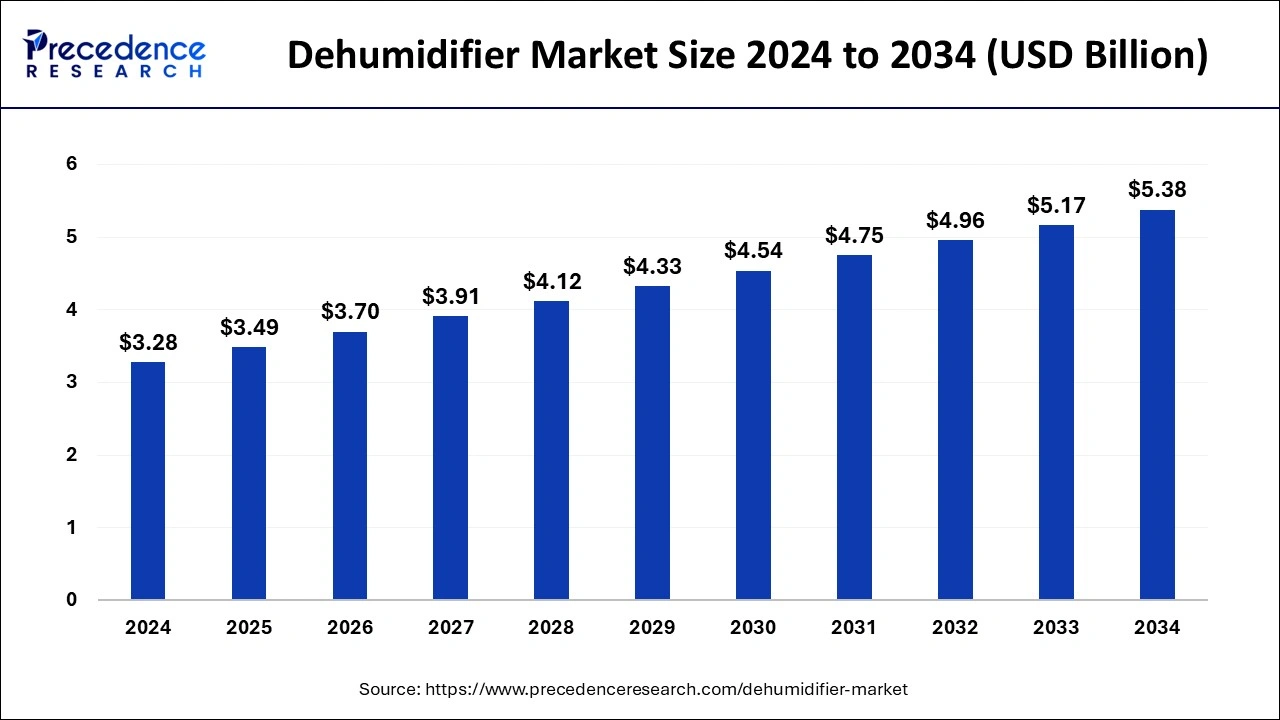
The incorporation of AI algorithms in dehumidifiers enhances their efficiency. AI algorithms automatically adjust the operation of dehumidifiers by monitoring humidity levels, temperature, and airflow in real-time. This automation is important in various sectors where controlling humidity is of utmost priority. Furthermore, AI’s predictive maintenance capability helps predict potential failures in dehumidifiers before they arise, which further helps reduce downtime and maintenance costs. The emergence of AI and ML technologies has also paved the way for the development of smart and energy-efficient dehumidifiers.
The U.S. dehumidifier market size was valued at USD 860 million in 2024 and is expected to reach around USD 1430 million by 2034, growing at a CAGR of 5.22% from 2025 to 2034.
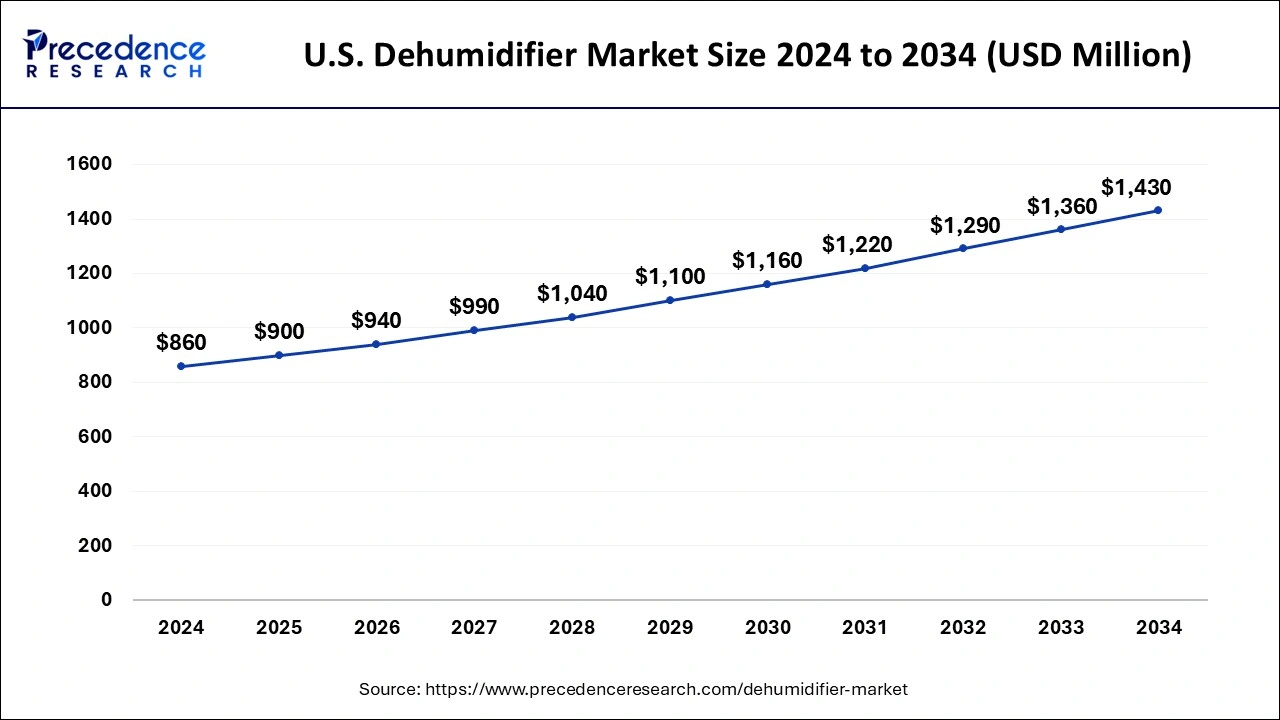
North America dominated the market with a 38% market share in 2024. particularly in the southern and coastal areas, experience high humidity levels. This creates a consistent demand for dehumidifiers, especially during the warm and humid seasons, to enhance indoor comfort and prevent issues like mold growth. Dehumidifiers are commonly used in residential settings to address moisture-related problems in basements, crawl spaces, and other areas of homes. Consumers are increasingly recognizing the importance of maintaining healthy indoor air quality, which has contributed to the demand for residential dehumidification solutions, which further drives demand for the market across the region.
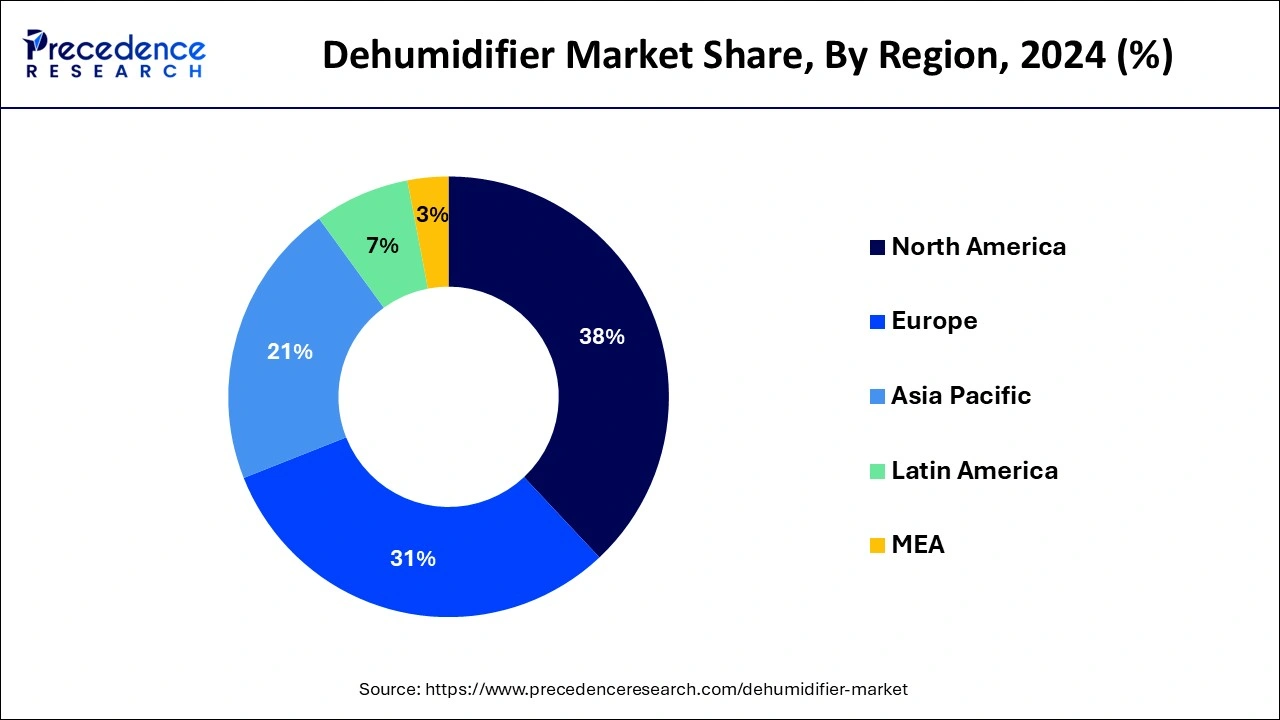
Asia-Pacific is poised for rapid growth of 7.6% in 2024 in the dehumidifier market due to many countries in the Asia-Pacific region experiencing high humidity levels due to their climate. This creates a demand for dehumidifiers in residential, commercial, and industrial applications to maintain comfortable and healthy indoor environments. Also, rapid urbanization and ongoing construction activities in the region contribute to the demand for dehumidifiers.
Meanwhile, Europe is growing at a notable rate in the dehumidifier. Europe experiences diverse climates, ranging from humid coastal regions to continental and northern climates. This diversity contributes to varying humidity levels in different parts of the continent, influencing the demand for dehumidifiers. The European market has shown an increased focus on energy efficiency, and this is reflected in the dehumidifier sector. Consumers and businesses alike are inclined toward energy-efficient appliances to reduce environmental impact and operational costs.
Dehumidifiers are appliances designed to reduce and maintain the level of humidity in the air within a specific space. These devices are commonly used in homes, commercial buildings, industrial facilities, and other environments to prevent issues such as mold growth, musty odors, and damage to sensitive materials. The market for dehumidifiers encompasses various types and sizes of these devices, catering to different needs and applications. Some common types of dehumidifiers include refrigerative dehumidifiers, desiccant dehumidifiers, and whole-house dehumidification systems. The market is influenced by factors such as climate conditions, geographical locations, construction trends, and awareness about indoor air quality.
| Report Coverage | Details |
| Growth Rate from 2025 to 2034 | CAGR of 5.07% |
| Market Size in 2025 | USD 3.49 Billion |
| Market Size by 2034 | USD 5.38 Billion |
| Largest Market | North America |
| Base Year | 2024 |
| Forecast Period | 2025 to 2034 |
| Segments Covered | By Technology, By Product, and By Application |
| Regions Covered | North America, Europe, Asia-Pacific, Latin America, and Middle East & Africa |
Increased awareness of the health risks
Growing awareness of health risks associated with high humidity levels is fueling a robust demand for dehumidifiers. As people become more conscious of the impact of indoor air quality on their well-being, the need for effective humidity control solutions is on the rise. High humidity can contribute to the growth of mold, dust mites, and other allergens, leading to respiratory issues and exacerbating allergies. Recognizing these health risks, consumers are increasingly turning to dehumidifiers to create healthier living spaces. The awareness of the link between indoor air quality and various health problems is not only driving demand in residential settings but also in commercial and industrial sectors.
Businesses, healthcare facilities, and educational institutions are investing in dehumidification solutions to maintain optimal indoor conditions, safeguarding the health of occupants and preserving sensitive equipment or materials. This heightened awareness is reshaping consumer priorities, making dehumidifiers a sought-after solution for those seeking to proactively address and mitigate the health risks associated with elevated humidity levels.
High initial cost
The high initial cost of dehumidifiers stands as a potential constraint, potentially impeding the widespread adoption of these devices. As consumers increasingly prioritize indoor air quality, the financial barrier posed by the upfront investment in dehumidifiers may hinder their widespread acceptance. In a market where cost considerations play a pivotal role in purchasing decisions, the perceived expense of acquiring a dehumidifier could deter some prospective buyers, particularly in price-sensitive segments.
Moreover, the initial investment may be perceived as disproportionate to the perceived benefits, especially in regions where humidity levels are not consistently high. Potential customers might weigh the cost against alternative solutions or choose to address humidity issues through less expensive means, such as natural ventilation or passive methods.
Advancements in energy-efficient technologies
The ongoing advancements in energy-efficient technologies within the dehumidifier market open up promising opportunities for sustainable growth. As environmental concerns and energy conservation become increasingly integral to consumer choices, the demand for energy-efficient dehumidifiers gains substantial traction. Manufacturers investing in research and development to create innovative, eco-friendly models are well-positioned to capitalize on this emerging market niche.
Moreover, energy-efficient dehumidifiers not only align with the growing global focus on sustainability but also address the longstanding concern of high energy consumption associated with traditional models. Consumers are becoming more discerning, seeking products that not only deliver optimal performance but also contribute to reduced energy consumption, translating into cost savings and environmental benefits.
The desiccant dehumidifier segment dominated the dehumidifier market with 58% in 2024. The segment is observed to continue the trend throughout the forecast period. Desiccant dehumidifiers employ a desiccant material, often silica gel, to absorb moisture from the air. The desiccant material attracts and holds moisture, and the process involves the rotation of a wheel or drum containing the desiccant. Desiccant dehumidifiers are particularly effective in low-temperature environments and are suitable for industrial applications, storage facilities, and areas with specific humidity control requirements.
The electronic/heat pump dehumidifier segment is expected to grow at a significant rate throughout the forecast period. Electronic or heat pump dehumidifiers function similarly to air conditioners. They pull in moist air, cool it to condense the moisture, and then reheat the air before releasing it back into the environment. This technology is versatile and suitable for various humidity levels, making it a popular choice for both residential and commercial use.
The fixed dehumidifier segment dominated the market with 59% in 2024. Fixed dehumidifiers, also known as whole-house or built-in dehumidifiers, are designed for permanent installation within a building's HVAC (Heating, Ventilation, and Air Conditioning) system. These units are typically larger and more powerful, providing comprehensive dehumidification for an entire home, office, or commercial space. Fixed dehumidifiers offer a centralized solution, integrated into the building's infrastructure to maintain consistent humidity levels throughout the structure. They are ideal for larger spaces or areas where continuous and efficient moisture control is essential.
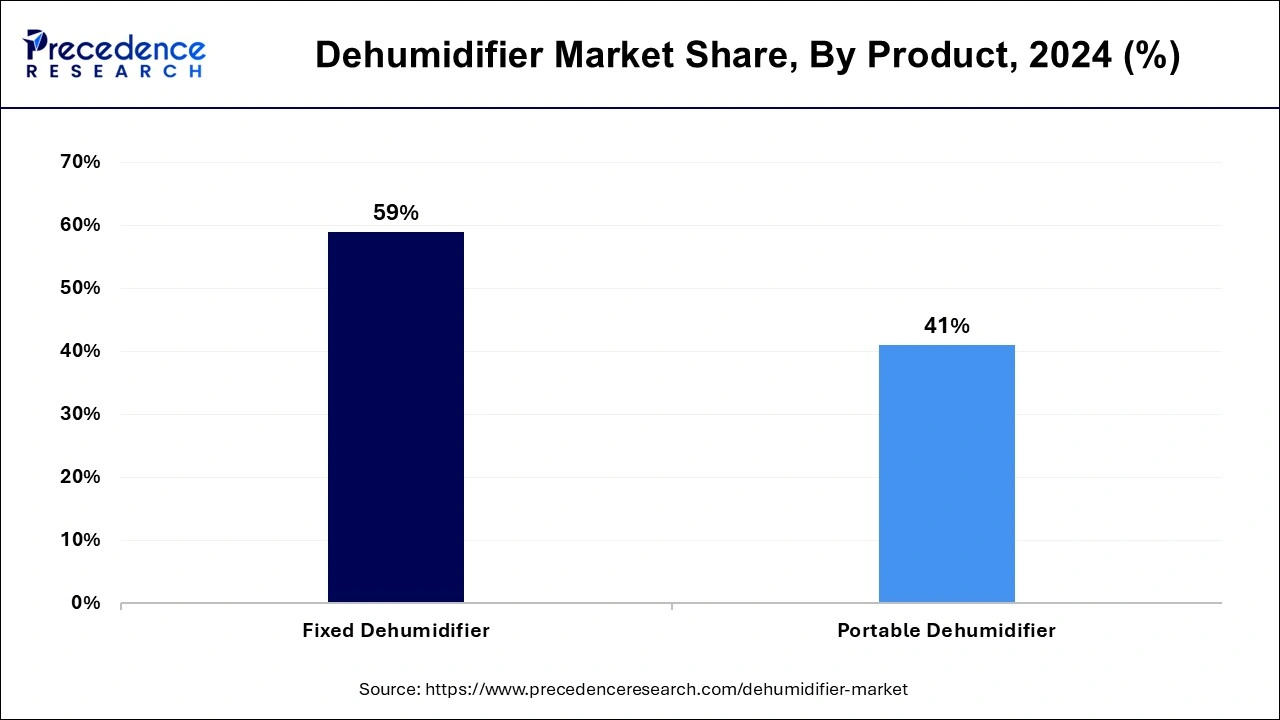
The portable dehumidifier segment is expected to grow at a CAGR of 7.3% during the forecast period. Portable dehumidifiers are compact, mobile units designed for easy movement from one room to another. They are suitable for smaller spaces, such as bedrooms, offices, or specific areas where temporary dehumidification is required. These units often feature wheels and a handle for convenient transportation. Portable dehumidifiers are popular among homeowners who want flexibility in targeting areas with high humidity levels or dealing with localized moisture issues. They are generally more affordable and offer a plug-and-play solution for on-the-go humidity control.
The industrial segment dominated the market with a share of 47% in 2024. The industrial segment focuses on dehumidifiers designed for heavy-duty applications in industrial settings. Industries such as manufacturing, pharmaceuticals, food processing, and warehouses often require precise humidity control for production processes, storage of materials, and preservation of products. Industrial dehumidifiers are robust, high-capacity units capable of handling large volumes of air and effectively controlling humidity in challenging industrial environments.
The residential segment is expected to grow at a CAGR of 7.4% during the forecast period. The residential segment encompasses dehumidifiers designed for use in homes and apartments. These dehumidifiers are typically smaller in size and are geared towards maintaining comfortable and healthy indoor environments for individuals and families. Residential dehumidifiers are commonly used in basements, bedrooms, living rooms, and other areas where excess humidity can lead to issues such as mold growth, musty odors, and discomfort.
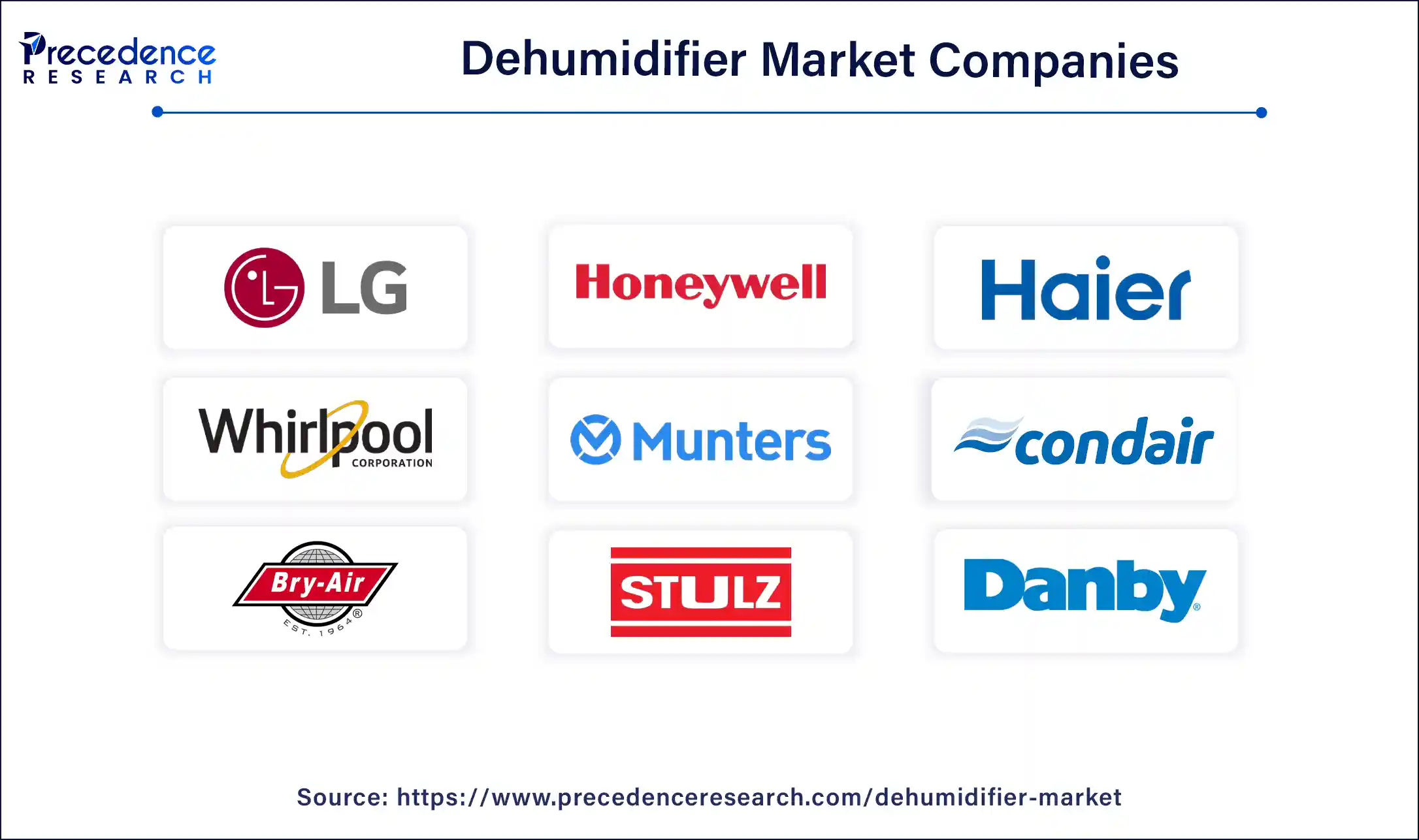
By Technology
By Product
By Application
By Geography
For inquiries regarding discounts, bulk purchases, or customization requests, please contact us at sales@precedenceresearch.com
No cookie-cutter, only authentic analysis – take the 1st step to become a Precedence Research client